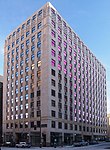Raspberry Island (Minnesota)
AC with 0 elementsGeography of Saint Paul, MinnesotaIslands of the Mississippi RiverLandforms of Ramsey County, MinnesotaMississippi National River and Recreation Area ... and 3 more
Parks in Saint Paul, MinnesotaRiver islands of MinnesotaUnited States Navy schools and training

Raspberry Island (formerly called Navy Island) is located in the Mississippi River in Saint Paul, Minnesota, United States. Buildings for the Minnesota Boat Club have sat upon the island since 1885; the Minnesota Boat Club Boathouse structure was built in 1910. Between 1949 and 1968, the island was used by the United States Navy. The City of Saint Paul manages the island as part of the Harriet Island Regional Park. Paths, a plaza, and a bandshell were installed on Raspberry Island during renovations by the city in the early 2000s.
Excerpt from the Wikipedia article Raspberry Island (Minnesota) (License: CC BY-SA 3.0, Authors, Images).Raspberry Island (Minnesota)
Sam Morgan Regional Trail, Saint Paul Downtown
Geographical coordinates (GPS) Address Nearby Places Show on map
Geographical coordinates (GPS)
| Latitude | Longitude |
|---|---|
| N 44.9421879 ° | E -93.0904963 ° |
Address
Wabasha Bridge
Sam Morgan Regional Trail
55146 Saint Paul, Downtown
Minnesota, United States
Open on Google Maps








